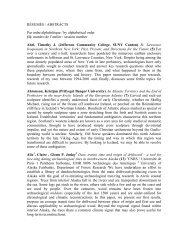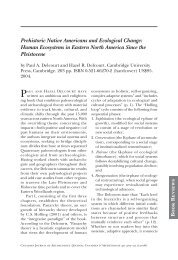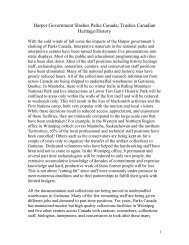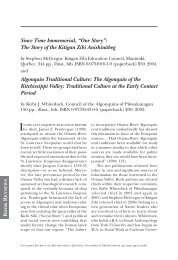16 - 20 MAI MAY 16 - 20 - Canadian Archaeological Association
16 - 20 MAI MAY 16 - 20 - Canadian Archaeological Association
16 - 20 MAI MAY 16 - 20 - Canadian Archaeological Association
Create successful ePaper yourself
Turn your PDF publications into a flip-book with our unique Google optimized e-Paper software.
inging human remains from Inuit graves to Chicago to add to the<br />
Field Museum collections. In 1927 Strong visited the former Moravian<br />
mission station of Zoar where he removed the remains of 22 individuals<br />
from marked graves in a Christian cemetery. A reburial was<br />
staged in 1928 to quiet local anger when people were outraged after<br />
learning about what happened and the facts of the matter remained<br />
unknown in Labrador for more than 80 years. In the Spring of <strong>20</strong>11<br />
the remains were returned to the Labrador Inuit and were reburied<br />
at Zoar.<br />
Braun, Gregory V. (University of Toronto) • Between Memory and<br />
Materiality: Biographies of Iroquoian Smoking Pipes [4]<br />
Smoking pipes are ubiquitous finds at many Iroquoian domestic settlements;<br />
however the traditional focus on their decoration may limit<br />
our understanding of the social and mechanical performance of these<br />
objects. This paper therefore employs a biographical approach in order<br />
to better understand the various contexts in which smoking pipes<br />
were manufactured, used and discarded. Petrographic, macroscopic<br />
and experimental techniques are used to examine the ceramic industries<br />
at two Middle Ontario Iroquoian villages that were occupied<br />
during the late 13 th century AD. The resulting data suggest that an important<br />
interplay existed between memory and materiality throughout<br />
the life-cycle of smoking pipes – beginning with the selection of<br />
symbolically charged raw materials for their manufacture, and ending<br />
with their decommissioning, deliberate breakage and discard.<br />
Brien, Marie-Claude (Université de Montréal) • Le cèdre blanc<br />
(Thuja occidentalis) dans le paysage culturel en amont de Montréal au<br />
XIX e siècle. Une approche dendroarchéologique [13]<br />
Le cèdre blanc est une essence forestière fortement utilisée dans les<br />
constructions rurales et urbaines du XIX e siècle. L’analyse dendrochronologique<br />
de six ensembles architecturaux ruraux composés de<br />
bâtiments en pièce-sur-pièce et situés dans les vallées de l’Outaouais<br />
et du haut Saint-Laurent nous a permis d’aborder l’établissement<br />
colonial d’une façon originale. Elle nous en apprend entre autres<br />
davantage sur le paysage culturel domestique et sur les différentes<br />
stratégies d’exploitation des ressources ligneuses. Les chronologies<br />
élaborées à partir de ces sites ruraux ont par ailleurs servi de points<br />
d’ancrage géographique dans la recherche de la région de provenance<br />
des pièces de cèdre blanc mis au jour sur cinq sites archéologiques<br />
montréalais. L’étude de dendroprovenance a permis de différencier<br />
quatre sous-régions d’approvisionnement du cèdre blanc pour<br />
Montréal au XIX e siècle, apportant une meilleure compréhension des<br />
réseaux d’échanges de cette ressource. Cette étude ouvre la voie à<br />
une compréhension renouvelée du patrimoine architectural et archéologique<br />
de Montréal et son amont.<br />
The Eastern white cedar (Thuja occidentalis) in the 19 th century cultural<br />
landscape of Montreal’s upstream valleys: a dendroarchaeological<br />
approach<br />
The Eastern white cedar appears widely in rural and urban construction<br />
of the 19 th century. Dendrochronological study of six rural<br />
building groups, made of stacked logs, in the Ottawa and Upper St.<br />
Lawrence Valleys sheds new light on colonial settlement patterns. It<br />
informs us on aspects of the domestic cultural landscape and on different<br />
strategies for exploiting this forest resource. The chronologies<br />
from these rural sites also serve as geographical anchorage points for<br />
a dendroprovenance study of white cedar timbers recovered from<br />
five archaeological sites in urban Montreal. We have differentiated<br />
four sub-regions that supplied cedar timber to Montreal in the 19 th<br />
century, leading to a better understanding of rural-urban trade networks<br />
for this resource. In these ways, the study refines our understanding<br />
of architectural and archaeological heritage in Montreal and<br />
its upstream hinterland.<br />
Brink, Jack W. (Royal Alberta Museum) • Rock Art and Graffiti Removal<br />
at the Okotoks Site: A Never Ending Problem [22]<br />
A large quartzite glacial erratic south of Calgary has red ochre rock<br />
art in a number of places. This prominent rock has been subjected<br />
to repeated graffiti making by visitors. A program of graffiti removal<br />
using high pressure water spray was undertaken, initially without<br />
archaeological consultation. This oversight led to a second project<br />
where graffiti was removed under close supervision by the author.<br />
Most graffiti falls on non-rock art surfaces but some directly overlies<br />
ochre images. Close inspection of water spraying suggests that no<br />
damage is being done to the underlying rock art. It appears that a<br />
mineral veneer has developed over the ochre, protecting it from damage.<br />
Though far from ideal, water spray removal of graffiti is one tool<br />
to address the never ending problem of continuous vandalism and<br />
protection of the rock art at the Okotoks site.<br />
Brink, Jack (Royal Alberta Museum) • Who’s the Guy with the Spoon<br />
on his Nose? [23]<br />
Peter Ramsden’s sole and entire contribution to my education has<br />
been to teach me about something called a Google-Smack: a juxtaposition<br />
of two words that is so bizarre that no Google search will find<br />
them linked together. Like domesticated fowl coming home to roost,<br />
I now see the words “Honour” and “Peter Ramsden” in the same sentence.<br />
As we pause to reflect on the deeper meaning of this, I provide<br />
a western perspective on Peter’s influence on <strong>Canadian</strong> archaeology.<br />
And in my remaining 19 minutes…<br />
Brownlee, Kevin (The Manitoba Museum) and Myra Sitchon (The<br />
University of Manitoba) • Shifting research paradigms in archaeological<br />
impact assessments of Hydroelectric Development Projects<br />
along the Churchill River in northern Manitoba [18]<br />
<strong>Archaeological</strong> investigations in northern Manitoba are driven primarily<br />
by hydroelectric development. The largest project involved<br />
a six year pre-impact archaeological assessment project prior to the<br />
diversion of the Churchill River into the Nelson River in 1976. Its inception<br />
occurred late into the planning process resulting in a lack of<br />
funding, understaffing and limiting its scope. Subsequent archaeological<br />
investigations began 14 years later in 1990 with a post mitigation<br />
reassessment of sites with outcomes that have significantly changed<br />
our perspectives on the ancient history of the region. More recently in<br />
Granville Lake, an area with a proposed hydroelectric dam, archaeological<br />
work initiated by the Okawamithikani First Nation with The<br />
Manitoba Museum, furthers our understanding of site identification<br />
and interpretation in the boreal forest. This presentation compares<br />
archaeological investigations carried out on the Churchill River since<br />
1969 and the role the local community plays in the recording of their<br />
history.<br />
Le développement hydroélectrique dans le nord du Manitoba constitue<br />
le principal moteur derrière la mise en place de programmes<br />
de recherches archéologiques. Réalisé avant la dérivation en 1976 du<br />
Fleuve Churchill vers la rivière Nelson, le projet de plus grande envergure,<br />
d’une durée de six ans, visait à évaluer les impacts de ce projet<br />
sur les ressources archéologiques. Sa mise en place tardive dans le<br />
processus de planification s’est traduit par un manque de financement<br />
et d’effectifs qui ont limité sa portée. Des recherches archéologiques<br />
entreprises 14 ans plus tard, soit en 1990, avaient pour but de réexaminer<br />
les sites qui avaient fait l’objet de mesures d’atténuation. Les<br />
résultats ont changé, de manière significative, notre perspective sur<br />
l’histoire ancienne de la région. Plus récemment, à Granville Lake, une<br />
région visée par la construction d’un autre aménagement hydroélectrique,<br />
le travail archéologique initié par la Nation d’Okawamithikani,<br />
en collaboration avec le Musée du Manitoba, a contribué à faire<br />
avancer notre interprétation et l’identification de sites en forêt boréale.<br />
Cette présentation compare les recherches archéologiques réalisées<br />
sur le Fleuve Churchill depuis 1969 et le rôle des communautés<br />
locales dans la collecte de données concernant leur histoire.<br />
Burke, A. 1 , Guiducci, A., Izquierdo, M., Levavasseur, G., ( 1 Département<br />
d’anthropologie, Université de Montréal) • Modelling climate<br />
variability during the Last Glacial Maximum and its impact on<br />
human population expansion [26]<br />
The “Groupe d’Étude des Dispersions d’Hominidés” was formed in<br />
<strong>20</strong>08 to investigate the impact of environmental change on the pattern<br />
of hominid dispersals. In this research, we use a high-resolution<br />
climate simulation to test the impact of climate variability on the<br />
distribution of human populations in the Iberian Peninsula during<br />
the Late Glacial Maximum. The effects of climate change on regional<br />
environments during the onset of full glacial conditions in the Iberian<br />
Peninsula is a hotly debated topic, our research helps shed light<br />
on this debate as well as exploring the relationship between climate<br />
variability and population dynamics during the early phases of the<br />
modern human colonisation of Europe.<br />
Burke, Adrian L. (Université de Montréal) • Trois-Rivières et Bécancour<br />
à la fin de l’Archaïque : résultats du projet triennal de l’Université<br />
de Montréal [29]<br />
30








